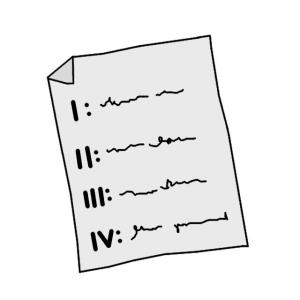Executive Summary
| Disclaimer: Links within the texts to additional information, concepts and tools are SSWM editor’s inputs and might not represent the view or practices of GIZ. |
Definition of a Status Report
A Status Report is a document containing the information related to the current situation of service provision in a city in regards to water supply, access to toilets, wastewater management, stormwater management and solid waste management. Furthermore, it should describe the demographic and social context of the city, and the projections of the future demands of the services. A status report should be complemented with a description of the existing institutional arrangements including the authorities and administrative structure, with their roles and responsibilities, as well the characteristics of the municipal finances, specially the incomes and expenditures in the given sectors. As the status report should be used for the definition of the Action Plans, it should describe the on-going and sanctioned initiatives, such as the City Development Plans, City Master Plans and existing Detailed Project Reports (DPR). In order to serve as a guidance to make decisions, the status report should also contain a SWOT analysis indicating the strengths and weaknesses of the city as well as the opportunities and threats given by the external environment. The objective of the status report is to identify a set of key issues that should draw special attention during the development of the strategies of the Action Plan.
Contents of a Status Report
A status report should be prepared by the Urban Local Body (ULB) in collaboration with a group of experts who are knowledgeable about the situation of the city and have experience with water and sanitation projects. In Shimla, Varanasi, Nashik, Raipur, Kochi and Tirupati, experts where contracted to facilitate and lead the process, who worked closely with the ULB officials (see also case studies Raipur and Kochi). As each city is different, and the level of information varies from place to place, each document should be tailor-made. However, it is suggested that the following components should be present:
- Introduction
- Overview of the city and institutional framework, including capacity enhancement aspects (see also invalid link)
- Water supply (see also chapters water sources, water purification and water distribution)
- Access to toilets (see also access to water and sanitation)
- Wastewater management (see also sanitation systems, wastewater collection and wastewater treatment)
- Storm water and receiving water bodies management (see also stormwater management)
- Solid waste management
- Municipal finances (see also government contributions)
- Conclusions
Meanwhile chapter 1 gives an introduction to the status report, the objectives of the study, scope of work and approach of methodology, chapter 2 serves as a presentation of the city with its divisions (wards) and projected demographics, as well as the institutional framework. It should list the State Level Agencies (like the State Water Supply and Sanitation Department, the Pollution Control Board, etc.) and their functions, as well as the Urban Local Bodies (ULBs), which depending on the size of the city can be classified as Municipal Councils or Municipal Corporations. The chapters to follow describe thoroughly the situation of the service delivery of the key components of water and sanitation.
How the chapters are organised will depend on the decision of the experts and the ULB officials, however the following suggestions are given:
- Decide on your planning units: Municipal Corporations in India are usually divided up into wards, which might have their own administrative body known as ward committees. It is recommended to analyse the service delivery based on the characteristics of each unit.
- Prepare thematic maps: a series of thematic maps prepared using GIS should accompany the status report as they facilitate spatial representation, shared understanding and better implementation. These might include maps on ward-wise population density and projections, water supply (see also chapters water sources, water purification and water distribution), sewerage, slums and visible open defecation spots (adapted from SMC et al. 2011).
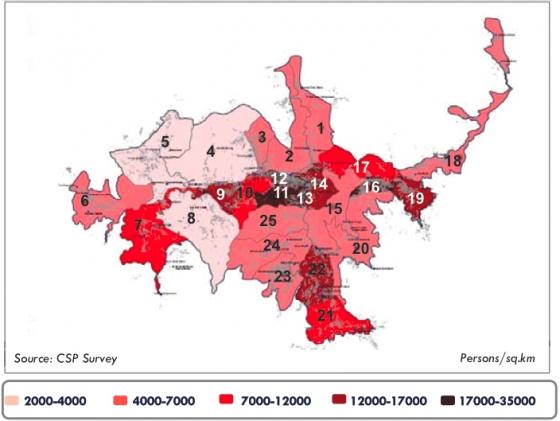
Example of thematic map showing the population density of wards in Shimla. Source: SMC et al. (2011)
- Compare with the Service Level Benchmarks (SLB) established by the Ministry of Urban Development, Government of India : this allows the comparison of existing levels of service in various sectors against the defined key parameters, giving the opportunity to identify the performance gaps. The following figure shows the benchmarks identified by the MoUD for water and sanitation components:
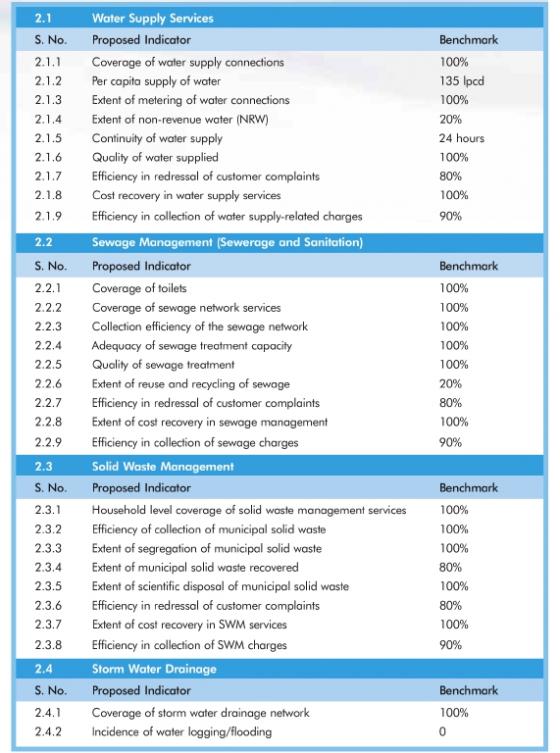
Service level benchmarks in water and sanitation. Source: MOUD (2010)
- Rate the quality of the service delivery through the National Award Scheme for sanitation for Indian cities at the beginning of the process: this exercise helps the cities to identify the priority areas of improvement, serving also as a baseline to measure the achievements in the future.
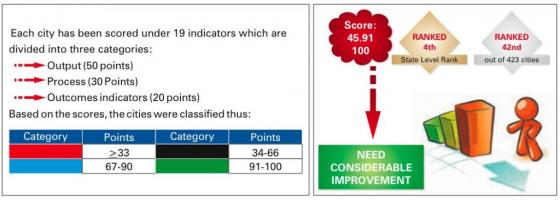
Example of a sanitation rating for Nashik, Maharashtra. Source: NMC et al. (2011)
- Include special sections for service levels and status in slums: “Inclusive sanitation focuses on covering everyone in the city irrespective of their legal status, i.e. low income settlements, regular floating population, or in specific period, specific professions like construction workers, informal employment and so on” (GTZ 2010, Report of the City Level Consultation Workshop). With the aim of considering “inclusiveness” as one of the strategic dimensions for CSP, a special attention has to be given to the service provided in low-income areas and slums.
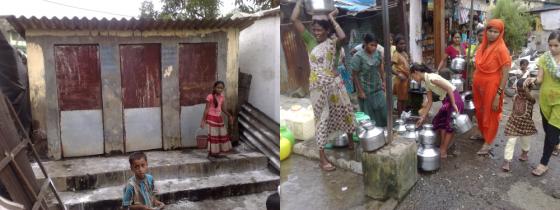
Situation in slums in India: Children using community latrines (left) and women fetching water (right). Source: L. BARRETO DILLON (2011)
- Include similar earlier, on-going and sanctioned projects: the status report should include a list of earlier similar initiatives taken by the State Government and ULB and their current status, which help in identifying the success and failure factors (GTZ 2010, Report of the Workshop on Developing a Framework). On-going activities, particularly already sanctioned Detailed Project Reports (DPRs) should be described for each component of sanitation.
- Identify key issues: in consultation with the authorities and based on the analysis of the experts, key issues (see also problem and preference ranking) have to be identified for each of the sanitation components: water supply, access to toilets, wastewater management, storm water management and solid waste management.
- Carry out a SWOT analysis: in addition to key issues, a SWOT analysis should identify the strengths, weaknesses, opportunities and threats in the different areas. These two exercises will facilitate the analysis of the information that will conclude with the development of the strategies at short, medium and long-term.
- Ensure ownership at city and state level: the process of ownership by the officials of the Municipal Corporation starts with the preparation of the status report. Despite the fact that specialists will be hired to facilitate the process, most of the data and information is within the Municipal Corporation. Therefore, it is important to clarify from the beginning what is expected from the ULB. A first draft of the status report should be shared with the Commissioner and the key officials within the Municipal Corporation for data validation. The experts and the municipality officials will then finalise the status report and share it with the City Sanitation Task Force (CSTF) (adapted from GTZ 2010, Report of the Workshop on Developing a Framework). As “the status report is the first formal output in the process of preparing the CSP, there is a need for approval of the same from both the city and the state” (GTZ 2010, Report of the Workshop on Developing a Framework).
Sources of Information
“The baseline information is categorised into primary and secondary information. The primary information is gathered through a series of field surveys and the secondary information is consolidated from several available official documents, reports, interviews, research publications” (RMC et al. 2011). The spatial information is of key importance to better understand the situation; therefore an effort should be made to create GIS maps. The quality and usefulness of the status report will depend on the information gathered; therefore it is required that all information cited is referred to the source of information to assure its quality and authenticity. The following picture gives an overview of the information needed in a status report:
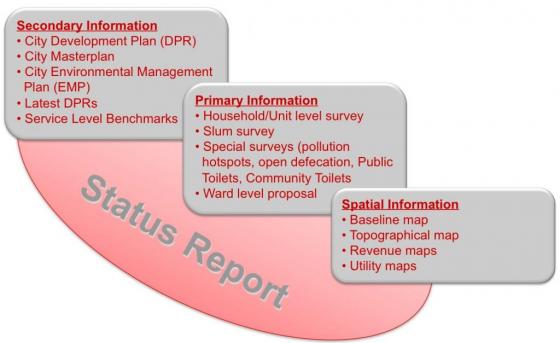
Information needed for the development of the status report. Source: DUBE 2012)
The process of how the information is compiled will be different in each city, since it depends on the information available, the team working on the status report and the communication process established. However, the following steps could be useful for the consultants when defining the strategy for data gathering (see also baseline data collection and chapters preliminary assessment of current status, definition of boundaries and stakeholder analysis):
- Define the information required: to start collecting information, you need to define the list of parameters and make an inventory of the data needed to produce a status report for each sanitation component. The MoUD has prepared a template called CSP Baseline Assessment listing all the information required.
- Interact with the ULB officials: most of the information will be available at the Municipal Corporation, it is thus of key importance to work together with the ULB officials to understand the situation in terms of existing information on demographics, infrastructure and level of coverage, institutional organisation and municipal finances.
- Define your available secondary data: collect documents such as City Development Plans, Master Plans, DPRs and other reports already existing describing the sanitation components. The census results of 2011, tables with ward population, reports prepared for other programmes (such as JNNURM), maintenance reports of public toilets, reports for environmental monitoring programmes, among other will help you to consolidate a first database.
- Collect primary data to complement your database:
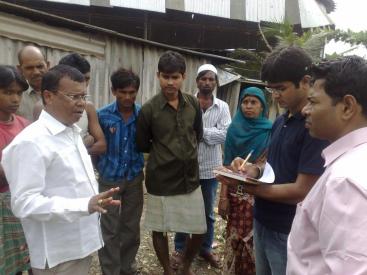
Collecting information directly from the beneficiaries. Source: L. BARRETO DILLON (2011)
the baseline information cannot be restricted to the secondary data collection, surveys and focus group discussions should be included in the status report to support or contradict the secondary information collected. Furthermore, surveys on the ground (e.g. transect walk) will allow to fill-in the gaps of those “on-the-ground sanitation issues” across households, commercial establishments, industrial units, slum pockets and public areas. Different survey’s methodologies can be applied, but there should be clarity on the objective to reach, the sample size and selection to ensure a well coverage across all the wards, the survey questionnaires and the methodology (see also baseline data collection, locality mapping and semi-structured interviews).
- Carry out reconnaissance visits and qualitative feedback: the questionnaire-based survey should be complemented with visits to various parts of the city, street corner meetings (e.g. transect walk) and interactions with opinion leaders (e.g. semi-structured interviews). The objective of this exercise is to capture insights into underlying issues and better understand the gaps and features of the sanitation infrastructure and service delivery in different parts of the city.
City Sanitation Plans: Experiences and Perspectives of State and ULBs in India
This presentation gives an overview about GIZ and its collaboration with the Government of India to fulfil the Indian National Urban Sanitation Policy’s vision that all Indian cities and towns become totally sanitized: i.e. the participatory approach of the City Task Force, how to process city wide baseline information, the 5 pillars for good City Sanitation Plans, comparison of NUSP and RAY, among others.
DUBE, R. (2012): City Sanitation Plans: Experiences and Perspectives of State and ULBs in India. National Workshop on Improving Services in Urban Water Supply and Sanitation New Delhi, July 9-10, 2012. Eschborn: Deutsche Gesellschaft fuer Internationale Zusammenarbeit (GIZ)Report of the City Level Consultation Workshop for the Preparation of City Sanitation Plans for selected JNNURM and UIDSSMT Cities. 15th and 16th April 2010 at Woodrose Club, Bangalore
This report presents the discussions that took place in the first consultation workshop organised by GIZ, consultants and other stakeholders. References regarding the formation of the CSTF can be found in more detail.
GTZ (2010): Report of the City Level Consultation Workshop for the Preparation of City Sanitation Plans for selected JNNURM and UIDSSMT Cities. 15th and 16th April 2010 at Woodrose Club, Bangalore. Eschborn: Deutsche Gesellschaft für Technische Zusammenarbeit (GTZ)Report of the Workshop on Developing a Framework for the preparation of the City Sanitation Plans. 29th September 2010 in New Delhi
This report contains the results of the workshop on developing a framework for the preparation of the CSPs conducted by GTZ with the CSP consultants for the cities. The objectives of the workshop were discussing the key issues in the status reports, identifying data gaps, discussing the issues in ensuring ownership at ULB/State level and developing a framework for the CSP outputs/recommendations.
GTZ (2010): Report of the Workshop on Developing a Framework for the preparation of the City Sanitation Plans. 29th September 2010 in New Delhi. Eschborn: Deutsche Gesellschaft für Technische Zusammenarbeit (GTZ)Handbook on Service Level Benchmarking
The Ministry of Urban Development initiated an exercise to develop standardised service level benchmarks with respect to basic municipal services. This Handbook is designed to enable the systematic and sustained monitoring of services using standardised indicators against agreed targets and benchmarks. It will help effect performance improvements in the identified service sectors.
MOUD (2010): Handbook on Service Level Benchmarking. New Delhi: Ministry of Urban Development, Government of India URL [Accessed: 05.11.2012]City Sanitation Plan for Nashik
This Brochure is a succinct overview of the City Sanitation Plan for City of Nashik in order to recognise the stress areas in the sanitation sector and establish priorities in the intervention areas along the defined strategic guidelines.
NMC GIZ IMACS (2011): City Sanitation Plan for Nashik. Nashik: Municipal Corporation Nashik in cooperation with GIZ and ICRA Management Consulting Services Limited (IMaCS) URL [Accessed: 06.11.2012]City Sanitation Plan for Raipur
This Brochure is a succinct overview of the City Sanitation Plan for City of Raipur in order to recognise the stress areas in the sanitation sector and establish priorities in the intervention areas along the defined strategic guidelines.
RMC GIZ CDD (2011): City Sanitation Plan for Raipur. Raipur: Municipal Corporation Raipur in cooperation with GIZ and Consortium for Dissemination of DEWATS URL [Accessed: 06.11.2012]City Sanitation Plan for Shimla
This Brochure is a succinct overview of the City Sanitation Plan for City of Shimla in order to recognise the stress areas in the sanitation sector and establish priorities in the intervention areas along the defined strategic guidelines.
SMC GIZ DCC (2011): City Sanitation Plan for Shimla. Shimla: Municipal Corporation Shimla in cooperation with GIZ and Consortium for Dissemination of DEWATS URL [Accessed: 06.11.2012]Report of the Workshop on Developing a Framework for the preparation of the City Sanitation Plans. 29th September 2010 in New Delhi
This report contains the results of the workshop on developing a framework for the preparation of the CSPs conducted by GTZ with the CSP consultants for the cities. The objectives of the workshop were discussing the key issues in the status reports, identifying data gaps, discussing the issues in ensuring ownership at ULB/State level and developing a framework for the CSP outputs/recommendations.
GTZ (2010): Report of the Workshop on Developing a Framework for the preparation of the City Sanitation Plans. 29th September 2010 in New Delhi. Eschborn: Deutsche Gesellschaft für Technische Zusammenarbeit (GTZ)Handbook on Service Level Benchmarking
The Ministry of Urban Development initiated an exercise to develop standardised service level benchmarks with respect to basic municipal services. This Handbook is designed to enable the systematic and sustained monitoring of services using standardised indicators against agreed targets and benchmarks. It will help effect performance improvements in the identified service sectors.
MOUD (2010): Handbook on Service Level Benchmarking. New Delhi: Ministry of Urban Development, Government of India URL [Accessed: 05.11.2012]City Sanitation Plan for Shimla
This Brochure is a succinct overview of the City Sanitation Plan for City of Shimla in order to recognise the stress areas in the sanitation sector and establish priorities in the intervention areas along the defined strategic guidelines.
SMC GIZ DCC (2011): City Sanitation Plan for Shimla. Shimla: Municipal Corporation Shimla in cooperation with GIZ and Consortium for Dissemination of DEWATS URL [Accessed: 06.11.2012]City Sanitation Plan for Kochi
This Brochure is a succinct overview of the City Sanitation Plan for City of Nashik in order to recognise the stress areas in the sanitation sector and establish priorities in the intervention areas along the defined strategic guidelines.
KMC GIZ IMACS (2011): City Sanitation Plan for Kochi. New Delhi: Municipal Corporation Nashik in cooperation with GIZ and ICRA Management Consulting Services Limited (IMaCS) URL [Accessed: 05.11.2012]Improving Urban Services though Service Level Benchmarking
This brochure offers a quick introduction to the Service Level Benchmarking Handbook developed and released by the Ministry of Urban Development of India.
MOUD (2010): Improving Urban Services though Service Level Benchmarking. New Delhi: Ministry of Urban Development, Government of India URL [Accessed: 08.11.2012]CSP Baseline Assessment
This table lists all the parameters and data required for the preparation of a baseline assessment for a City Sanitation Plan according to the Ministry of Urban Development of India.
MOUD (2011): CSP Baseline Assessment. New Delhi: Ministry of Urban Development, Government of India URL [Accessed: 08.11.2012]Rating of cities: National Urban Sanitation Policy. Frequently Asked Questions
This brochure offers a quick overview of the rating exercise applied by the National Urban Sanitation Policy. The topics cover brief answers to questions like: what is the rating exercise? How frequently will it be undertaken? How was the data collected? And many more.
MOUD ; WSP (2011): Rating of cities: National Urban Sanitation Policy. Frequently Asked Questions. New Delhi: Ministry of Urban Development and the Water and Sanitation Program (WSP) of the World Bank URL [Accessed: 08.11.2012]http://www.urbanindia.nic.in/
This web page of the Ministry of Urban Development of India gives a throughout description on how to improve urban services through Service Level Benchmarking. Here you can also find direct link to the SLB handbook and further guidelines.
http://censusindia.gov.in
The Indian Census is the most credible source of information on demography, housing and household amenities, and other data in India. It presents information on water and sanitation per districts in all states of the country.
http://www.mdws.gov.in
In order to manage the groundwater resources better, the Ministry of Drinking Water and Sanitation of India in collaboration with the National Remote Sensing Centre, has prepared groundwater prospects maps for 14 states in the country, so far. These 1:50000 scale maps organised toposheet-wise, possess comprehensive spatial data on groundwater and can help identify locations for open wells or borewells, as well as locations of groundwater recharge structures.

